After my previous musing, I thought I might share some more in depth thoughts on the subject…
…it must needs be that there was an opposition; even the forbidden fruit in opposition to the tree of life; the one being sweet and the other bitter. (2 Nephi 2:15)
So which was sweet and which was bitter. Surely our first thought must lead us to believe that the fruit of the tree of life was sweet, but not so (despite the opinions I’ve read on other blogs and sites). It was the forbidden fruit (the fruit of the tree of knowledge of good and evil) that was sweet.
The fruit of the one which was “bitter” was the tree of life, and the forbidden fruit was the one which was “sweet to the taste” Harold B. Lee CR April 56 page 109.
Harold B. Lee also stated:
Now that is the way it ofttimes sounds, that the things that are forbidden are the things which are the most desirable, and the things that are right for us are sometimes pretty bitter pills for us to swallow, as we say. (Teachings of Harold B. Lee pg. 13-14)
It makes sense to me that the fruit of the tree of knowledge of good and evil was sweet to the taste. It is a desireable thing to have knowledge of good and evil. Recognizing the sweetness of the fruit of this tree may have meant that yes, they possibly did partake of the fruit of the tree of life. God say they could surely eat of any tree in the garden except for the fruit of the tree of knowledge of good and evil.
… it must needs be that the devil should tempt the children of men, or they could not be agents unto themselves; for if they never should have bitter they could not know the sweet. (D&C 29:39)
So this begs the question, was the tree of life that Lehi partook of in his dream the same tree of life in the garden of eden? The surroundings sound much different and there was no cheribum and flaming sword guarding it. This one I don’t know. It may have been “just a parable.” It does represent the tree of life in the interpretation given by Nephi.
And just maybe the fruit of the tree of life is “most precious and most desirable above all other fruits” now, but was not at the time. Have any of us eaten fruit that tasted bitter, but would have been more sweet if we’d just given it a bit more time to ripen?
